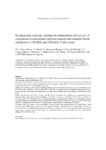Mostrar o rexistro simple do ítem
Do physicians correctly calculate thromboembolic risk scores?: a comparison of concordance between manual and computer‐based calculation of CHADS2 and CHA2DS2‐VASc scores
| dc.contributor.author | Esteve-Pastor, María Asunción | |
| dc.contributor.author | Marín, Francisco | |
| dc.contributor.author | Bertomeu-Martínez, Vicente | |
| dc.contributor.author | Roldán, Inmaculada | |
| dc.contributor.author | Cequier, Ángel | |
| dc.contributor.author | Badimón, Lina | |
| dc.contributor.author | Muñiz, Javier | |
| dc.contributor.author | Valdés, Mariano | |
| dc.contributor.author | Anguita, Manuel | |
| dc.date.accessioned | 2019-02-26T09:24:52Z | |
| dc.date.available | 2019-02-26T09:24:52Z | |
| dc.date.issued | 2016-03-01 | |
| dc.identifier.citation | Esteve-Pastor MA, Marín F, Bertomeu-Martínez V, et al. Do physicians correctly calculate thromboembolic risk scores?: a comparison of concordance between manual and computer‐based calculation of CHADS2 and CHA2DS2‐VASc scores. Intern Med J. 2016; 46(5): 583-589 | es_ES |
| dc.identifier.issn | 1444-0903 | |
| dc.identifier.uri | http://hdl.handle.net/2183/21961 | |
| dc.description.abstract | [Abstract] BACKGROUND: Clinical risk scores, CHADS2 and CHA2 DS2 -VASc scores, are the established tools for assessing stroke risk in patients with atrial fibrillation (AF). AIM: The aim of this study is to assess concordance between manual and computer-based calculation of CHADS2 and CHA2 DS2 -VASc scores, as well as to analyse the patient categories using CHADS2 and the potential improvement on stroke risk stratification with CHA2 DS2 -VASc score. METHODS: We linked data from Atrial Fibrillation Spanish registry FANTASIIA. Between June 2013 and March 2014, 1318 consecutive outpatients were recruited. We explore the concordance between manual scoring and computer-based calculation. We compare the distribution of embolic risk of patients using both CHADS2 and CHA2 DS2 -VASc scores RESULTS: The mean age was 73.8 ± 9.4 years, and 758 (57.5%) were male. For CHADS2 score, concordance between manual scoring and computer-based calculation was 92.5%, whereas for CHA2 DS2 -VASc score was 96.4%. In CHADS2 score, 6.37% of patients with AF changed indication on antithrombotic therapy (3.49% of patients with no treatment changed to need antithrombotic treatment and 2.88% of patients otherwise). Using CHA2 DS2 -VASc score, only 0.45% of patients with AF needed to change in the recommendation of antithrombotic therapy. CONCLUSION: We have found a strong concordance between manual and computer-based score calculation of both CHADS2 and CHA2 DS2 -VASc risk scores with minimal changes in anticoagulation recommendations. The use of CHA2 DS2 -VASc score significantly improves classification of AF patients at low and intermediate risk of stroke into higher grade of thromboembolic score. Moreover, CHA2 DS2 -VASc score could identify 'truly low risk' patients compared with CHADS2 score. | es_ES |
| dc.language.iso | eng | es_ES |
| dc.publisher | Wiley | es_ES |
| dc.relation.uri | https://doi.org/10.1111/imj.13048 | es_ES |
| dc.rights | This is the peer reviewed version of the article which has been published in final form at Wiley Online Library. This article may be used for non-commercial purposes in accordance with Wiley Terms and Condiitons for self-archiving. | es_ES |
| dc.subject | Atrial fibrillation | es_ES |
| dc.subject | Stroke risk score | es_ES |
| dc.subject | Oral anticoagulation | es_ES |
| dc.subject | Antithrombotic treatment | es_ES |
| dc.subject | CHA2-DS2-VASc score | es_ES |
| dc.title | Do physicians correctly calculate thromboembolic risk scores?: a comparison of concordance between manual and computer‐based calculation of CHADS2 and CHA2DS2‐VASc scores | es_ES |
| dc.type | info:eu-repo/semantics/article | es_ES |
| dc.rights.access | info:eu-repo/semantics/openAccess | es_ES |
| UDC.journalTitle | Internal Medicine Journal | es_ES |
| UDC.volume | 46 | es_ES |
| UDC.issue | 5 | es_ES |
| UDC.startPage | 583 | es_ES |
| UDC.endPage | 589 | es_ES |






